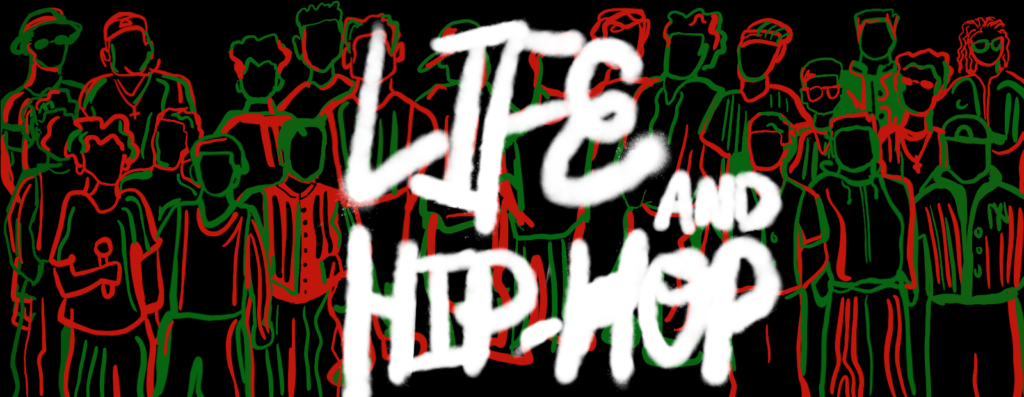Life and Hip-Hop: Crossover between music and film broadens genre’s cultural impact

(Emily Dembinski/Illustrations director)

By EJ Panaligan
March 10, 2021 7:01 p.m.
The impact of music extends far beyond the play and pause buttons. Formed in the 1970s as an underground movement, hip-hop has expanded into various art forms and musical subgenres – with rap specifically being one of the most popular musical styles among today’s youth. In “Life and Hip-Hop,” columnists Natalie Brown and EJ Panaligan explore and analyze how hip-hop intersects with and influences everyday aspects of life.

Much like a rap verse can paint a vivid picture, a film camera can tell an equally engaging story – and bringing them together invites an endless world of creative possibilities.
The high-concept, artistically-driven nature of today’s popular hip-hop visuals did not come about in one night. Before they started embracing the film-like qualities of narrative-based storytelling, hip-hop music videos showcased the basics: live music, rappers and a grooving crowd – elements that would go on to become classic staples of the genre’s identity.
Such was the case with The Sugarhill Gang’s “Rapper’s Delight,” which was the first popular hip-hop track to be accompanied by a music video. The visuals were, at their core, a live performance of the group’s song at The Soap Factory Disco show in New Jersey. But Adam Bradley, an English professor and founding director of UCLA’s Laboratory for Race and Popular Culture, said the music video was crucial in highlighting something special: hip-hop music in motion.
“That video was essentially an attempt to capture hip-hop in the wild,” Bradley said. “Hip-hop, after all, began not as a musical form, but as a cultural happening. It was something that you did, not something that you listened to.”
Bradley said the visualization of Black spaces and environments is a characteristic of hip-hop music videos that distinctly differentiates them from other genres’ videos. Specifically, he said this quality is evident in Grandmaster Flash & The Furious Five’s “The Message,” whose music video offered glimpses of inner-city poverty and strife highlighted in the song’s lyrics, while the artists rapped their verses on the New York City streets they called home.
“You’d see urban spaces, you’d see Black and Brown people at the center of the stories,” Bradley said. “You’d see a broader swath of cultural performances.”
[Related: Life and Hip-Hop: Grammy Awards have long history of snubbing hip-hop, Black artists]
The creative relationship between hip-hop and its visual forms progressed even further as the genre began to influence the production of feature films, namely in director Spike Lee’s 1989 film “Do The Right Thing.” The film was made with hip-hop in mind – Lee tasked rap group Public Enemy with writing its theme song, “Fight The Power,” which is used throughout. Wade Dean, a musicology postdoctoral candidate, said the song functioned concurrently with the film’s general themes of Black oppression and adversity in America.
“What did Radio Raheem have? That boombox. What was it playing? ‘Fight The Power,’” Dean said. “What (Lee) was showing us was, the way that, in this particular moment of time, Black life was seen as arbitrary and disposable.”
Lee’s use of the boombox playing this particular Public Enemy song throughout the film functions as a representation of the sounds of Black life, Dean said. The physical destruction of the boombox signaled an emotional turning point in the film, which he said alluded to the Radio Raheem character’s eventual death scene with the sounds of Black life being snuffed out, both literally and figuratively.
Beyond serving as the musical themes and motifs of films, hip-hop artists themselves began to appear on the big screen more prominently in the ‘90s, playing featured roles in popular movies. Films like “Boyz n the Hood” and “Juice” weren’t specifically about hip-hop, but Dean said the on-screen presence of rappers like Ice Cube and Tupac Shakur made these films indistinct from the genre.
“It’s not even the soundtrack, it’s just the sound of the movie, it’s language happening in conversation with one another,” Dean said. “Cube isn’t (rapping), Tupac isn’t (rapping) in ‘Juice,’ but they’re almost like conduits, the music is coalescing around them.”
[Related: Hip-Hop in Motion]
Hip-hop and its visual forms reached new heights of recognition in the early 2000s when the films “8 Mile” and “Hustle and Flow” won Academy Awards for Best Original Song at the Oscars for Eminem’s “Lose Yourself” and Three 6 Mafia’s “It’s Hard Out Here for a Pimp,” respectively. Bradley said this form of critical reception helped further entrench the genre’s place within popular culture.
“It used to be that hip-hop was deemed an element of popular culture as something that, for the longest time, was thought to be a passing fad,” Bradley said. “We’re at a point now where there are very few parts of our society and our culture that are not influenced in one way or another by hip-hop.”
Today, hip-hop music stands on equal footing with the films it accompanies, evidenced recently by director Ryan Coogler’s 2018 Marvel film “Black Panther.” Rapper Kendrick Lamar’s curated soundtrack of original music for the film brought in positive critical and cultural reception, with the inspirational “All The Stars” earning an Oscar nomination for Best Original Song. For fourth-year English student Maya Gutierrez, these artistic collaborations between the film and music world serve to uplift hip-hop and Black art in general.
“I think (hip-hop soundtracks in films) build a sense of community, especially within the hip-hop and Black community,” Gutierrez said. “It makes me feel like I’m watching a piece of hip-hop art and Black art, and it’s being elevated every time.”


